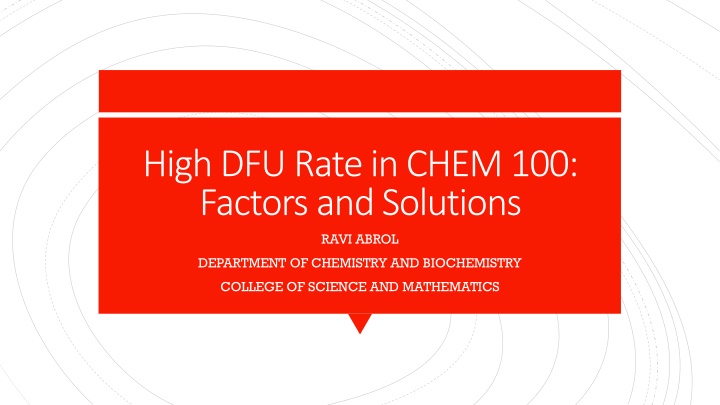
Factors and Solutions for High DFU Rate in CHEM 100
Explore the factors contributing to the high DFU rate in CHEM 100 and effective solutions to reduce this rate and achievement gap. Peer Learning Facilitator (PLF) sections have shown significant success in decreasing DFU rates by 50% and increasing pass rates by 50%. The next step is to consider implementing PLFs across all sections to enhance student success.
Download Presentation

Please find below an Image/Link to download the presentation.
The content on the website is provided AS IS for your information and personal use only. It may not be sold, licensed, or shared on other websites without obtaining consent from the author. If you encounter any issues during the download, it is possible that the publisher has removed the file from their server.
You are allowed to download the files provided on this website for personal or commercial use, subject to the condition that they are used lawfully. All files are the property of their respective owners.
The content on the website is provided AS IS for your information and personal use only. It may not be sold, licensed, or shared on other websites without obtaining consent from the author.
E N D
Presentation Transcript
High DFU Rate in CHEM 100: Factors and Solutions RAVI ABROL DEPARTMENT OF CHEMISTRY AND BIOCHEMISTRY COLLEGE OF SCIENCE AND MATHEMATICS
What are some of the underlying factors behind high DFU rate in CHEM 100? Guiding Questions What interventions inside or outside of class are effective in reducing the DFU rate and Achievement gap in CHEM 100?
Data for 3959 First-Time-Freshmen Students admitted between years 2008-2011, who took CHEM 100 CHEM 100 Grade Ethnicity PELL status Gender High School GPA SAT Math SAT Verbal Parent Education Level Overview of Data Peer Learning Facilitator Section Data by Dr. Dorothy Nguyen-Graff from Chemistry for 6087 First-Time- Freshmen Students admitted between years 2008-2017, who took CHEM 100 CHEM 100 Grade PLF Section Ethnicity PELL Status High School GPA Math Proficiency? Open-ended assessment class intervention data by Dr. Li Ye from Chemistry.
CHEM 100 Grade correlates: positively with being in PLF sections, High School GPA, SAT Scores, Parent Education Level, and Math proficiency. negatively with Under-Represented Minority status and PELL Grant status. PLF sections (logistics managed by Dr. Dorothy Nguyen-Graff in Chemistry) have a 50% lower DFU rate and a 50% higher Pass rate (C or better) than non-PLF CHEM 100 sections. Mean CHEM 100 grade in PLF sections is: 2.3 and in non-PLF sections is: 1.5. PLF Section CHEM 100 Total Yes (872) No (5215) 26 67 Findings DFU (< C-) Pass (> C-) 51 44 47 47 Open-ended assessments run by Dr. Li Ye in Chemistry are showing strong promise in reducing achievement gaps.
Peer Learning Facilitator (PLF) sections have been shown to dramatically reduce DFU rates in CHEM 100 by up to 50% and increase Pass rate (C or better) by up to 50%. Open-ended assessments are showing promise in reducing achievement gaps in first-generation traditionally underserved students. Concluding thoughts Next step is to figure out, what it will take to implement PLFs across all sections in CHEM 100, in terms of resources and uniformity of adoption in all sections.
